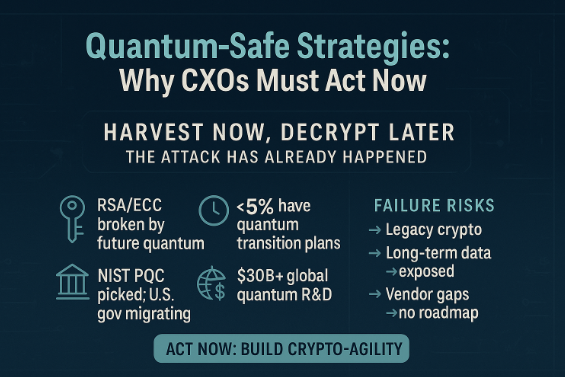Every time I talk to executives about quantum computing, I hear the same response: “Isn’t that still ten years away?” Maybe. Maybe not. But here’s the problem: Your data doesn’t care about a calendar.
Right now, adversaries are stealing encrypted data and putting it on ice. They don’t need to crack it today. They’ll wait until tomorrow, when quantum computing matures enough to break encryption methods we’ve trusted for decades. This “harvest now, decrypt later” model means the attack has already happened — you just won’t feel the pain until years down the line.
That’s why quantum-safe planning is not a future exercise. It’s a leadership imperative in 2025.
Why Quantum Changes the Game
For decades, RSA and ECC encryption have been the bedrock of digital trust. Your bank transactions, medical records, defense contracts, and even the humble email are all protected by these algorithms.
But quantum computing rewrites the rules. Using Shor’s algorithm, a sufficiently powerful quantum computer could crack RSA-2048 encryption in hours — or even minutes. The once “unbreakable” walls of our digital world could crumble overnight.
This isn’t a niche, academic problem. It cuts across every industry:
- Finance: Long-term transactions, loan agreements, and payment networks.
- Healthcare: Patient records that must stay private for decades.
- National Security: Classified data with multi-decade sensitivity.
- Cloud & SaaS: Millions of businesses rely on trust in vendors’ security.
Here’s the catch: Even if large-scale quantum computers are five or ten years away, the shelf life of sensitive data is often much longer. Which means if someone steals it now, they’re already ahead of the game.
The State of Enterprise Readiness
Unfortunately, most companies aren’t even close to ready. Studies show fewer than 5% of enterprises have formal quantum transition plans.
Why? Because leadership assumes quantum is a “next decade” problem. But enterprise risk doesn’t run on a ten-year cycle. Budgets, contracts, compliance frameworks, and infrastructure refreshes happen every year. By the time quantum reaches a practical tipping point, it’ll be far too late to react if you haven’t started already.
Governments certainly aren’t waiting. NIST has already selected a first set of post-quantum cryptography (PQC) algorithms, and the U.S. federal government is mandating migration for its systems. The EU, China, and Japan are pouring billions into quantum R&D. The race is on — and businesses that snooze on quantum resilience will be left exposed.
What a Quantum-Safe Strategy Looks Like
So, what should the C-suite be doing today?
- Inventory and risk assessment: Start by identifying where sensitive data is stored, how long it must remain secure, and which systems are most exposed.
- Crypto agility: Your systems must be able to swap in new algorithms without requiring full-scale rebuilds. Designing for agility now saves years of pain later.
- Pilot PQC standards: Begin testing NIST’s recommended PQC algorithms in sandbox environments. Build muscle memory before regulators force your hand.
- Prioritize high-value systems: Focus first on data with long-term sensitivity: patient records, intellectual property, critical infrastructure, and government contracts.
- Engage partners: Demand roadmaps from cloud providers, SaaS vendors, and hardware suppliers. If they don’t have a quantum-safe strategy, neither do you.
Leadership Responsibility: Not Just the CISO’s Job
This cannot be punted to the CISO alone. Quantum risk is an enterprise risk. CIOs, CFOs, COOs and boards must recognize the financial, reputational, and regulatory stakes.
Think about it: What happens when a competitor can assure customers and regulators they are quantum-safe, while you’re still trying to form a steering committee? This is brand trust, customer retention and market leadership on the line.
Quantum-safe readiness must sit alongside cyber resilience, ESG and digital transformation as a top-tier board agenda item.
The Global Landscape
Around the world, governments and enterprises are treating this with urgency:
- The U.S. CHIPS and Science Act earmarks billions for quantum research and PQC adoption.
- The NSA has ordered all national security systems to begin quantum migration.
- The EU’s Quantum Flagship program is pushing post-quantum standards for financial services.
- China is openly prioritizing quantum supremacy as part of its broader digital competition strategy.
This isn’t just a technology issue — it’s a geopolitical one. Enterprises that drag their feet will not only face technical debt but also regulatory penalties and competitive disadvantages.
Shimmy’s Take
Here’s the reality: Quantum computing is not science fiction anymore. Whether the tipping point is three years away or ten, the clock is already ticking — and adversaries are already collecting the keys to your kingdom.
The real danger isn’t that we don’t have the technology yet. It’s that we’re running out of time to prepare.
Every CXO must reframe their perspective: this isn’t about being first with quantum-safe systems. It’s about not being last. Because if your competitors, your regulators, and your adversaries all move faster than you, your business will be standing in quicksand.
Digital leaders must ensure their enterprises are crypto-agile, testing PQC and treating quantum resilience as a board-level mandate.
Waiting for the first “quantum cyber Pearl Harbor” is not a strategy. It’s surrender.

